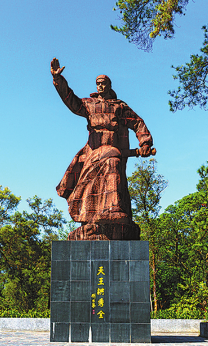Area serves as a hot spot for Red tourism

Jintian Town in Guiping city, an area under Guigang's administration, is a cradle of the Taiping Rebellion. CHINA DAILY
With its abundant cultural and historical attractions, Guigang is a crucial port city in the Guangxi Zhuang autonomous region. It is also seeing new routes for development with Red tourism.
According to a government official, there are more than 300 revolutionary historical sites in the city.
A large number of them are places that have sowed the seeds of communism and witnessed a precious history.
Through comprehensive excavating and rebuilding work, the local government has cultivated a group of Red tourism sites and turned them into reliable sources of revenue.
In 2017, Guigang started on the construction work of seven education bases, which include the former sites of the Guangxi special commission of the Communist Party of China, the Red revolutionary education base of Mid-Autumn Uprising, the former residence of Tan Shoulin, an outstanding CPC member and one of the main leaders of the early Party organizations in Guangxi, the former residence of Chen An and the memorial site of the first Guangxi Congress of the CPC.
The memorial site of the first Guangxi Congress of the CPC, which took place on June 1, 1928, is now a key heritage site under national-level protection.
The congress was held in secret on Guicheng Street in the city's Gangbei district. As the first session of provincial-level congress since the founding of the Party commission in Guangxi in 1925, it made possible deploying the Party's rebuilding work.
At the meeting, the Party leaders systematically summed up the lessons of Guangxi Party organizations after many failures and strengthened the Party's leadership, which played a vital role in promoting Guangxi's revolution.
The memorial site of the Guangxi Congress of the CPC, also called the Sanliluo village conference, is another cultural relic in the city.
On the evening of Nov 7, 1936, the Guangxi Congress of the CPC was held in secret in the hall of Qin Zengqi's house in Sanliluo village, Guixian county.
The meeting announced the official establishment of the Guangxi provincial working committee of the CPC, unified leadership of the Party organizations in the whole province and helped recover contact with the CPC Central Committee.
Over the past 100 years, a large number of revolutionary martyrs have emerged in Guigang. Among them are Huang Rikui, the first CPC member from Guangxi; and Hu Futian, the only representative of the Guangxi Party organization who attended the Sixth National Congress of the CPC in Moscow.
In addition to the heroic stories of the CPC members, Jintian Town in Guiping city, an area under Guigang's administration, is a cradle of the Taiping Rebellion.
The rebellion is the largest peasant uprising in Chinese history and was led by Hong Xiuquan 170 years ago.
The key heritage sites are under national-level protection and listed as national-level Red tourism spots.
Visitors are flocking to the sites to have a taste of the history and enjoy the cultural relics, murals and artworks presented under the help of acousto-optic technology and 3D displaying methods.














